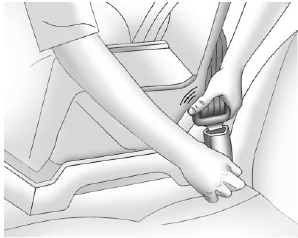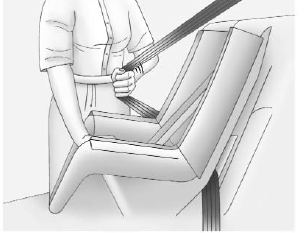Chevrolet Equinox Owners Manual: Securing Child Restraints (With the Seat Belt in the Rear Seat)
When securing a child restraint with the seat belts in a rear seat position, study the instructions that came with the child restraint to make sure it is compatible with this vehicle.
If the child restraint has the LATCH system, see Lower Anchors and Tethers for Children (LATCH System) for how and where to install the child restraint using LATCH. If a child restraint is secured in the vehicle using a seat belt and it uses a top tether, see Lower Anchors and Tethers for Children (LATCH System) for top tether anchor locations.
Do not secure a child seat in a position without a top tether anchor if a national or local law requires that the top tether be anchored, or if the instructions that come with the child restraint say that the top strap must be anchored.
If the child restraint or vehicle seat position does not have the LATCH system, you will be using the seat belt to secure the child restraint. Be sure to follow the instructions that came with the child restraint.
If more than one child restraint needs to be installed in the rear seat, be sure to read Where to Put the Restraint.
- Put the child restraint on the seat.
- Pick up the latch plate, and run
the lap and shoulder portions
of the vehicle's seat belt
through or around the restraint.
The child restraint instructions will show you how.

- Push the latch plate into the
buckle until it clicks.
Position the release button on the buckle, away from the child restraint system, so that the seat belt could be quickly unbuckled if necessary.

- Pull the shoulder belt all the way out of the retractor to set the lock. When the retractor lock is set, the belt can be tightened but not pulled out of the retractor.

- To tighten the belt, push down
on the child restraint, pull the
shoulder portion of the belt to
tighten the lap portion of the
belt, and feed the shoulder belt
back into the retractor. When
installing a forward-facing child
restraint, it may be helpful to
use your knee to push down on
the child restraint as you
tighten the belt.
Try to pull the belt out of the retractor to make sure the retractor is locked. If the retractor is not locked, repeat Steps 4 and 5.
- If the child restraint has a top tether, follow the child restraint manufacturer's instructions regarding the use of the top tether. See Lower Anchors and Tethers for Children (LATCH System).
- Before placing a child in the child restraint, make sure it is securely held in place. To check, grasp the child restraint at the seat belt path and attempt to move it side to side and back and forth. When the child restraint is properly installed, there should be no more than 2.5 cm (1 in) of movement.
To remove the child restraint, unbuckle the vehicle seat belt and let it return to the stowed position.
If the top tether is attached to a top tether anchor, disconnect it.
 Replacing LATCH System
Parts After a Crash
Replacing LATCH System
Parts After a Crash
Warning
A crash can damage the LATCH
system in the vehicle. A damaged
LATCH system may not properly
secure the child restraint,
resulting in serious injury or even
death in a ...
 Securing Child Restraints (With
the Seat Belt in the
Front Seat)
Securing Child Restraints (With
the Seat Belt in the
Front Seat)
This vehicle has airbags. A rear
seat is a safer place to secure a
forward-facing child restraint. See
Where to Put the Restraint.
In addition, the vehicle has a
passenger sensing system which ...
Other materials:
Rear Bumper Upper Fascia Replacement Bumpers Rear Bumper
Rear Bumper Upper Fascia ReplacementCalloutComponent NamePreliminary ProcedureRemove the rear bumper fascia molding. Refer toRear Bumper Fascia Molding Replacement.1Rear Bumper Upper Fascia Screw (Qty:-2)Caution:Refer toFastener Caution.Tighten6-Y(53-lb-in)2Rear Bumper Upper FasciaProcedureCarefully ...
